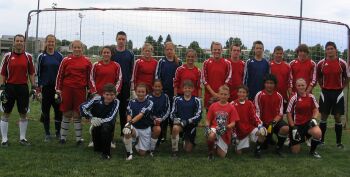
|
"Outstanding keeper instruction. This is a must for goalkeepers and coaches." —Ottawa Internationals S.C. web site, Ottawa, Canada |

|

|
Top |
Goalkeeping Tips, Tidbits and Random Thoughts
An athlete talking to themsleves during competition is hardly a new phenomenon.... The talk does not have to be vocal. By merely thinking you are talking to yourself and sending a message.
-- Tony DiCicco, Goalkeeper Soccer Training Manual
If you have a question, comment or rebuttal you'd like to see addressed here, send me email. I will post your mail to the blog at my discretion unless you specify otherwise.
Training attitude
Whew. Campers on their way home, tired and happy. And, I hope, with some improved skills. Overall it was a great group, solid skill-wise and willing to work hard. I hope the players enjoyed it as much as I did.
During the last morning session there was one tense moment where there was a collision on a breakaway. Nothing intentional, but with players as tired as they were tempers got short. We took a quick breath and moved on, but it raised the point that if you want to get better, you have to train at full intensity... and if you go all out, there is the possibility of injury.
It can be difficult to get players to put as much effort into practice as into the real game. But if you don't provide your teammates the best opposition possible, how will anyone get any better? I once heard that Arsenal in England trains so intensely that players feel the game on the weekend is easier than practice! You need to be careful, but to help your teammates get better, you need the same focus, intensity and aggression in training as you do in the match.
We always end camp with a Keeper Wars session. Here are a few variations we've used:
- Vanilla Keeper Wars, 1v1 for one or two minute matches.
- Doubles, with two keepers in each goal and alternating serves. Make sure keepers are staggered one in front and one in back to prevent collisions.
- Mini Keeper Wars, using poles or corner flags to make goals about 10-12 yards apart and only allowing underhand thrown serves.
- Team Keeper Wars, you stay in goal until you either get scored on or miss the frame; then you get out of goal and your next teammate steps in.
- 4-Way, with two pairs of goals forming a square. You only compete against the keeper in the goal opposite you, but any rebounds into the area can be finished by any keeper in any goal (first-time shot). It gets crazy with balls flying everywhere!
- Use a few mini-balls mixed in as the "money ball" which scores two points.
Labels: Psychology, Training
Which keeper are you?
This evening's camp topic was tipping over the bar. I love this session for several reasons: 1) it is technically demanding (footwork, hands, timing) and I enjoy helping kids get the precision needed to make the save, 2) the players really want to learn how to do it and work hard, and 3) I have fun chipping the ball over them and scoring—and get excited when they make a great save. Win-win.Over the course of the week, you get to see individual personalities emerge. You two types of perfectionists, one type who just keeps going and going and going until they get it right, another type who gets down on themselves when it isn't perfect, even if it's very good. You have the diligent student who nods and says, "Yes coach" to everything. You have the goofy kid who may not be the best goalkeeper but enjoys being there and doing all the drills. Sometimes you get the stud who thinks they know it all already (and the coaches have to make sure to take down a peg or two), or a player who is there for the wrong reasons, to socialize rather than work hard. That may be okay at some camps, but not at Star Goalkeeper Academy or Net Results Soccer Training. If there is one attribute I want any camper to have (or for that matter, any player I train), it is a good work ethic.
Best keeper game ever
One of the all-time favorite keeper camp games we call Shaggers. Our version for keepers is as follows:Field: Full-size goal with lines marked 6 yards out and 16 yards out. Two marker cones 22 yards from goal, even with the goalposts. There is a server at one goalpost with lots of balls.
Teams: Two equal teams of at least 4 players.* Each team forms a line behind one of the marker cones. Team A puts one of their players in goal to start as keeper.
Play: The coach servers a ball to the first player in the team B line, who must shoot first time from behind the 16-yard line on the Team A keeper. If the B player misses or the shot is saved, the A keeper leaves the goal and goes to the back of the A line, and the B player is in goal. Coach then serves to the first person in the A team line to shoot on the B keeper.
If a player scores on the first shot, they get a second shot that must be a header or volley from outside the 6. If a player scores both goals, the goalkeeper who was scored upon is out. The shooter then takes their place in goal.
Continue until one team is eliminated. *If you have fewer than 8 players, you can play with a single line of shooters and make it keeper vs keeper.
It's called "Shaggers" because of all the missed shots that have to be rounded up. After all, it is keeper camp, not striker camp.
Today's sessions were foot skills and receiving backpasses (the early morning session), collapsed diving, crosses, and distribution games. With the exception of diving, these are all areas where many keepers tend to be weak. Foot skills and crosses especially are two areas that separate the top goalkeepers from the rest. And crosses even more specifically are something that most goalkeepers do not get enough training on.
Labels: Training
Focus, focus, focus
The campers came dragging out to the morning session today. The first day everyone was chipper, eager and working hard. Many of them had had a pre-breakfast session of footwork and plyometrics, and by the time they'd all digested breakfast and got back out onto the field the lethargy showed.When you are tired, we all know the first thing to go is your brain. The coaches were disappointed with the effort and focus in the morning session on ball handling. Basic stuff—the meat and potatoes of the goalkeeper's job—but done far too sloppily. We rode them a bit, an it got better, but come on, it's only the second day!
You get out of training what you put into it. As Malcolm Gladwell puts it, "The people at the very top don't just work much harder than everyone else. They work much, much harder."
The afternoon session on positioning was much better and the keepers really improved as it went along. And then for the evening (before the thunderstorm and the dorm fire alarm went off!) we played Shaggers: The. Best. Keeper. Game. Ever. Got to see some absolutely ridiculous saves.
I'll describe the game in a forthcoming post. And for those of you across the pond, get your mind out of the gutter... over here, "to shag" means to round up stray balls. Ahem.
Labels: Training
First impressions
Our first two sessions today with a new group of goalkeepers. Lots of simple ball handling exercises: high balls, low balls, catching, serving. Who has the basics down, who needs work. Who is agressive, who is passive, who is a leader, who follows. It's a bit like a tryout, in that we are trying to sort the players somewhat so they will be training with players at a similar level for the rest of the week.Why should you—or anyone—try to make a good first impression? Whether it's at a tryout, a camp, or an everyday team training session, shouldn't you always try to put your best foot forward? At the very least, show your strengths. Coaches will spot the weaknesses.. but of course, that's their job, right? To see the weaknesses and try to make you better.
But if you can show your strengths, the coaches can focus on the weaknesses, rather than having to take you through the basics that you thought you already had down.
That's why good habits are so important, in every training session. Because how you do things habitually, every time, without thinking, is how you are going to make the best first impression.
Labels: Training
Camp notes
I'm busy gearing up for the first big camp weekend of the summer, coaching for Star Goalkeeper Academy. This is probably one of the most intense camps out there; certainly one of the few residential camps that are strictly for goalkeepers. Train, eat, sleep, train, repeat. With three (or even four) training sessions daily, it is a grueling but incredibly rewarding experience.I always look forward to the first evening, looking over a batch of young keepers, some new, some returning. It's interesting to see the mix of players—ages, ability levels—and wonder how far we can take them in a week.
I be making regular posts this week on our progress.
Labels: Training
Recognition
Ways to get recognized:1. Do something extraordinary. Just once. Make the championship-winning save or score the game-winning goal. Bring in the big contract. Rescue someone from a burning building. Sometimes it is luck, but more often it is the result of preparation ("Luck is where preparation meets opportunity." —Seneca).
2. Do something for a very long time. Work for 35 years and get the gold watch. Toil as a starter—but not the star—for a 15-year career. You have to have the perseverance to stick it out for the long haul, be satisfied out of the limelight, and be a team player. You also have to be good enough they still want you around.
3. Do something extraordinarily well for a very long time. This, of course, is the most difficult of the three.
How will you earn your recognition?
Labels: Psychology, Training
Character
Losing builds character. Ever heard that saying?It's wrong.
Losing reveals character.
What do you do after a loss? Use your emotion as a springboard for improvement, not an excuse to sulk. "Life is 10% what happens to you, and 90% how you react to it." —Lou Holtz
Labels: Psychology
Action bias among elite soccer goalkeepers
Action bias among elite soccer goalkeepers: The case of penalty kicks. Huh? What in the world does that mean?A forthcoming study shows that most goalkeepers will pick a side (based on reading the shooter, gut feel, or just plain guessing) and dive there, when in fact the optimal strategy is to stay in the middle and react—as I often advocate, especially for younger players.
So why then do goalkeepers pick a direction and dive? That's the title of the article. There is a bias towards "action": i.e., doing something. The thought is that if you're going to get scored on anyway, you might as well get scored on while trying hard than just standing there doing nothing. Certainly, a keeper who never moves while the ball goes into the corner of the net doesn't usually provoke a positive reaction from teammates or coach.
However, almost 30% of the 286 penalties included in the study were struck to the middle third of the net, and the goalkeeper's chance of saving such a shot is about 60%, versus about a 25-30% chance of saving a shot hit to one side even when the keeper dives the correct way. So why dive to the side at all? Because "an identical negative outcome (a goal being scored) is perceived to be worse when it follows inaction rather than action." In other words, keepers are biased towards action.
The upshot of all this? I think it supports my theory of stopping penalty kicks: don't guess and dive, read the shooter and get a feel for where you think the shot will go, get prepared to go that way, but don't go too soon and leave yourself some ability to react after the ball is struck. That strategy works quite successfully for me, and I've saved more than my fair share of penalties struck down the middle.
Labels: Penalty Kicks
A simple training tool
I find many more dropped balls are due to problems withe the eyes than with the hands. Often, keepers will take their eyes off the ball a split second before the ball is actually secured, leading to a bobble. Perhaps they are looking up to distribute quickly, or are worried about an onrushing opponent. But there is a simple practice trick to get keepers to focus their eyes.Take a ball you will train with and get a permanent marker. On every panel, write a large capital letter. Most balls have 32 panels and there are only 26 letters, so to make up the difference also use the numbers 1, 2, 3, 4, 5 and 8 (make sure to make your "one" and "letter i" look different).
Now, every time the keeper catches the ball, they must say aloud the letter facing them. This keeps the eyes locked in on the ball until well after the catch is secure.
This patented "Alpha-Ball" (not really, but I expect credit—and a small royalty—if you make a lot of money off this idea!) is a simple training tool for encouraging proper focus on the catch. Get your keepers into a good habit using this and I can almost guarantee fewer dropped balls.